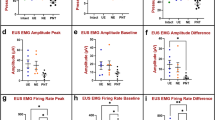Abstract
Objective
In recent studies, it has been observed that androgen receptors are densely located in pelvic floor muscles. We aimed to investigate the effect of testosterone on urodynamic findings and histopathomorphology of pelvic floor muscles in rats with experimentally induced stress urinary incontinence.
Materials and methods
Twenty-eight adult female rats were randomized into four groups. Group I: rats in which SUI was induced and single-dose testosterone was administered 30 days later, group II: rats in which SUI was induced and single-dose testosterone was administered within the same session, group III: rats in which SUI was induced and saline was injected intramuscularly 30 days later, and group IV: the sham group. In order to demonstrate objectively the curative and preventive role of testosterone in experimental model of SUI, urodynamic examination and histopathomorphological evaluation of levator ani muscle were performed.
Results
Myofiber areas in groups I and II were detected to be significantly larger than those of the control group (P < 0.001). Another parameter was leak point pressure value by urodynamy. Regarding this parameter, LPP values in groups 1, 2 and 4 were observed to be significantly higher than those of group 3 (P < 0.001). The results of the comparison among groups 1, 2 and 4 revealed no significance (P > 0.05), which indicates that testosterone provides continence in a similar way to the group in which sciatic nerve section was not performed.
Conclusions
In the present study, it has been demonstrated that testosterone has both preventive and curative effects on rat models of experimental SUI.


Similar content being viewed by others
References
Fantl JA, Bump RC, Robinson D et al (1996) Efficacy of estrogen supplementation in the treatment of urinary incontinence. The continence program for women research group. Obstet Gynecol 88:745–749
De Lancey JO, Anatomy (2002) İn: Cardozo L, Staskin D (eds) Textbook of female urology and urogynaecology, Martin Dunitz ltd., London pp 111–124
Ulmsten U (1997) Some reflections and hypotheses on the pathophysiology of female urinary incontinence. Acta Obstet Gynecol Scand 166:3–8
Padero MCM, Bhasin S, Friedman TC (2002) Androgen supplementation in older women: too much hype, not enough data. J Am Geriatr Soc 50:1131–1140
Ferrando AA, Sheffield-Moore M, Paddon-Jones D et al (2003) Differential anabolic effects of testosterone and amino acid feeding in older men. J Clin Endocrinol Metab 88:358–362
Herbst KL, Bhasin S (2004) Testosterone action on skeletal muscle. Curr Opin Clin Nutr Metab Care 7:271–277
Nnodim JO (1999) Quantitative study of the effects of denervation and castration on the levator ani muscle of the rat. Anat Rec 255:324–333
Lee JY, Cannon TW, Pruchnic R, Fraser MO, Huard J, Chancellor MB (2003) The effects of periurethral muscle-derived stem cell injection on leak point pressure in a rat model of stress urinary incontinence. Int Urogynecol J Pelvic Floor Dysfunct 14:31–37
Zhao J, Zhang Y, Zhao W et al (2008) Effects of nandrolone on denervation atrophy depend upon time after nerve transection. Muscle Nerve 37:42–49
DeLancey JO (1994) Structural support of the urethra as it relates to stress urinary incontinence: the hammock hypothesis. Am J Obstet Gynecol 170:1713–1730
DeLancey JO, Kearney R, Chou Q, Speights S, Binno S (2003) The appearance of levator ani muscle abnormalities in magnetic resonance images after vaginal delivery. Obstet Gynecol 101:46–53
Mc Guire EJ, O’Connell HE (1996) Leak point pressures in stress urinary incontinence. Atlas of Urodynamics. Blaivas JG and Chansellor M (eds), Williams and Wilkins, Baltimore pp. 208–213
Hay-Smith EJC, Dumoulin C. (2006) Pelvic floor muscle training versus no treatment, or inactive control treatments, for urinary incontinence in women. Cochrane review. The Cochrane Library
Chiaffarino R, Chatenoud L, Dindelli M et al (1999) Reproductive factors, family history, occupation and risk of urogenital prolapse. Eur J Obstet Gynecol Reprod Biol 82:63–67
Lucacs ES, Lawrence JM, Contreras R, Nager CW, Luber KM (2006) Parity, mode of delivery and pelvic floor disorders. Obstet Gynecol 107:1253–1260
Wilson PD, Bo K, Hay-Smith J, Nygaard I, Staskin D, Wyman J (2002) Conservative treatment in women. In: Abrams P, Cardozo L, Khoury S, Wein A (eds) Incontinence. Plymbridge Distributors Ltd, Plymouth, pp 571–624
Matsuura S, Downie JW (2000) Effect of anesthetics on reflex micturition in the chronic cannula-implanted rat. Neurourol Urodyn 19:87–99
Hanzal E, Berger E, Koelbl H (1993) Levator ani muscle morphology and recurrent genuine stress incontinence. Obstet Gynecol 81:426–429
Zhu L, Lang J, Chen J, Jie Chen (2005) Morphologic study on levator ani muscle in patients with pelvic organ prolapse and stress urinary incontinence. Int Urogynecol J 16:401–404
Bhasin S, Taylor WE, Singh R et al (2003) The mechanisms of androgen effects on body composition: mesenchymal pluripotent cell as the target of androgen action. J Gerontol A Biol Sci Med Sci 58:1103–1110
Author information
Authors and Affiliations
Corresponding author
Rights and permissions
About this article
Cite this article
Mammadov, R., Simsir, A., Tuglu, I. et al. The effect of testosterone treatment on urodynamic findings and histopathomorphology of pelvic floor muscles in female rats with experimentally induced stress urinary incontinence. Int Urol Nephrol 43, 1003–1008 (2011). https://doi.org/10.1007/s11255-011-9938-5
Received:
Accepted:
Published:
Issue Date:
DOI: https://doi.org/10.1007/s11255-011-9938-5




